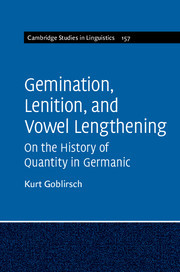Description
Gemination, Lenition, and Vowel Lengthening
On the History of Quantity in Germanic
Cambridge Studies in Linguistics Series
Author: Goblirsch Kurt
The interrelationship between three major quantity changes in the history of the Germanic languages: gemination, lenition, and open syllable lengthening.
Language: English
Subject for Gemination, Lenition, and Vowel Lengthening:
Approximative price 34.17 €
In Print (Delivery period: 14 days).
Add to cart
Gemination, Lenition, and Vowel Lengthening
Publication date: 10-2020
Support: Print on demand
Publication date: 10-2020
Support: Print on demand
Approximative price 120.27 €
In Print (Delivery period: 14 days).
Add to cart
Gemination, Lenition, and Vowel Lengthening : Volume 157
Publication date: 05-2018
292 p. · 15.8x23.5 cm · Hardback
Publication date: 05-2018
292 p. · 15.8x23.5 cm · Hardback
Description
/li>Contents
/li>Biography
/li>
The processes of gemination, lenition, and vowel lengthening are central to the study of phonology, as they reveal much about the treatment of quantity in a given language. Using data from older language stages, modern dialects and standard languages, this study examines the interdependence of vowel and consonant quantity in the history of the Germanic branch of Indo-European. Kurt Goblirsch focusses on the various geminations in Old Germanic languages (West Germanic gemination, glide strengthening, and expressive gemination), open syllable lengthening in German, Dutch, Frisian, English, and Scandinavian languages, and the major lenitions in High German, Low German, and Danish, as well as minor lenitions in Bavarian, Franconian, and Frisian dialects. All of these changes are related to the development of the Germanic languages from distinctive segmental length to complementary length to syllable cut. The discussion challenges traditional theoretical assumptions about quantity change in Germanic languages to argue for a new account whereby, gemination, lenition, and vowel lengthening are interrelated.
1. Theoretical preliminaries; 2. The road to complementary length: gemination and quantity in Old Germanic; 3. Arriving at the goal: vowel lengthening in Middle Germanic; 4. The reaction of consonants: lenition in Middle Germanic; 5. Quantity types in Modern Germanic.
Kurt Goblirsch is professor of German and Linguistics at the University of South Carolina. He is author of Consonant Strength in Upper German Dialects (1994), Lautverschiebungen in den germanischen Sprachen (2005), and is co-editor of the journal NOWELE.
© 2024 LAVOISIER S.A.S.




